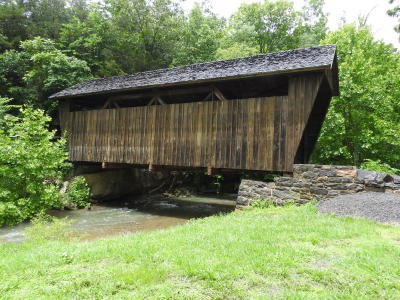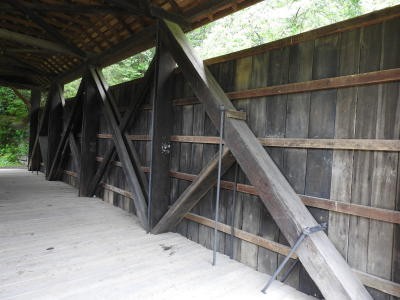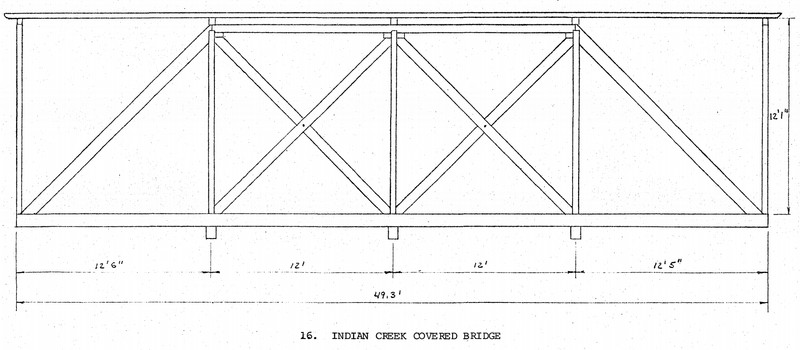Indian Creek Covered Bridge
Introduction
Text-to-speech Audio
Images
Indian Creek Covered Bridge

Interior view of the bridge. The Long trusses used are visible

Architectural sketch of the Long trusses used for the bridge

Backstory and Context
Text-to-speech Audio
In 1898, the Monroe County Court expressed interest in creating a new bridge over Indian Creek to make agricultural transport easier. Brothers Ray and Oscar Weikel were awarded the contract despite being only sixteen and eighteen years old, respectively. Their uncles, established sawmill owners in Monroe County, served as guarantors for the work of their nephews. The brothers immediately set up their own sawmill adjacent to the site of the new bridge. Initial court plans for the Indian Creek Covered Bridge utilized an arched structure. However, the Weikels presented designs for a flat bridge that were accepted.
Oxen delivered timber to the Weikel’s sawmill to be shaped for the bridge. Horses and wagons delivered the finished pieces from the sawmill to the bridge site. The Weikels designed a geared machine operated by teams of four men to lift the enormous beams into place with less effort than hand-placing them. All components of the bridge were made by the brothers except for the iron rods, nails, and shingles. The bridge was completed at some point between 1898 and 1903. Ray and Oscar were paid $400 for their work – approximately $12,000 adjusted for inflation. Though this seems like low compensation for their work, the Weikel’s success with the bridge established them as qualified carpenters within Monroe and Greenbrier County.
In addition to the superstructure built by the Weikel brothers, the Indian Creek Covered Bridge rests upon limestone abutments. It is extremely unlikely that the brothers built the abutments. Masonry and carpentry were skilled labors requiring specific study. The ability to do both is relatively unprecedented and unnecessary. It is possible E. P. and A. P. Smith created the abutments, as they are mentioned as builders of the bridge by the West Virginia Department of Transportation, but this is speculative. In any case, the abutments are fitted without mortar and have required no modification or reinforcement over the years – a testament to the high quality of craftsmanship.
The Indian Creek Covered Bridge measures approximately fourteen feet wide and fifty feet long. It is built using a modification of the Long truss style. This truss was patented by Stephen H. Long in 1830. It consists of vertical posts connected by diagonal crossbeams sloping towards the center. However, the Long trusses used in the Indian Creek Covered Bridge have two perpendicular diagonal crossbeams rather than a single one. A defining feature of the Long truss that can be seen in the Indian Creek Covered Bridge is that the trusses are constructed entirely of wood. The bridge was walled with vertical pine boards while a gabled roof of chestnut shingles capped the structure.
For thirty years, the Indian Creek Covered Bridge served its local community. In 1929, it was abandoned and fell into disrepair. The Monroe County Historical Society immediately began restoration when they leased the bridge in 1965. This included repairing siding, replacing the floor, and re-shingling the roof. For many years, the historical society used the bridge to house a collection of horse-drawn vehicles. In 2000, the bridge was restored once again by Hoke Brothers Construction for $334,446. This restoration involved repair of the trusses, another new deck, new siding, and a new roof of split shakes. These days, the bridge serves only pedestrian traffic. One of only two extant covered bridges in Monroe County, the Indian Creek Covered Bridge stands as a monument to the ingenuity of two teenagers in a remote community.
Sources
Hanson, Todd A. Covered Bridges, The West Virginia Encyclopedia. May 28th 2019. Accessed August 17th 2020. https://www.wvencyclopedia.org/articles/1660.
Indian Creek Covered Bridge, West Virginia Department of Transporation. Accessed August 17th 2020. https://transportation.wv.gov/highways/bridge_facts/covered-bridges/Pages/IndianCreekCoveredBridge.aspx.
KCI Technologies, Inc and Mead & Hunt, Inc. West Virginia Statewide Historic Bridge Survey: Final Survey Report, Highways Through History. April 1st 2015. Accessed August 17th 2020. https://www.highwaysthroughhistory.com/Content/bridges/WVSHBSFinalSurveyReport.pdf.
Schmidt, Jack, J. P., and Brian McKee. Indian Creek Covered Bridge, Bridge Hunter. November 15th 2019. Accessed August 17th 2020. https://bridgehunter.com/wv/monroe/indian-creek-covered/.
Turley, C. E., and James E. Harding. Indian Creek Covered Bridge, National Register of Historic Places. April 1st 1975. Accessed August 17th 2020. https://npgallery.nps.gov/NRHP/GetAsset/7f5d7ba0-d021-43ba-b4b0-70d26ff4b00f.
Jack Schmidt
Jack Schmidt
C. E. Turley and James E. Harding
